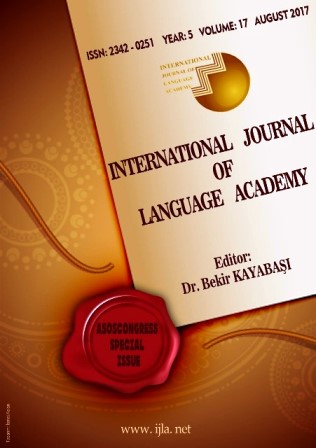TÜRKÇE ÖĞRETİM MATERYALİ OLARAK 19. YÜZYILDA ERMENİ HARFLİ TÜRKÇE İLE YAZILMIŞ “TURKİSH PROVERBS…” KİTAPLARININ KARŞILAŞTIRMALI İNCELEMESİ
Author :
Abstract
Yabancı dil olarak Türkçe öğretiminin tarihi incelendiğinde, Avrupa’da ve İstanbul’da 19. Yüzyıl boyunca Türkçe öğretmeye yönelik olarak yabancılar tarafından çok sayıda kitap yayımlandığı görülmektedir. Bunların büyük bir kısmı Gramer üzerinedir. Ancak kısmen de olsa okuma parçaları ve Türkçe atasözleri de içeren kitaplar da yayımlanmıştır. Yayımlanan kitaplar genellikle İngilizce, Fransızca gibi hedef kitlenin dili esas alınarak Latin harfleriyle yayımlanmıştır. Örnek olarak kullanılan Türkçe kelime veya metinlerde ise önce Arap harfli orijinali yazılmış, sonra Latin harflerine transkribe edilmiş sonra da ilgili dildeki anlamı verilmiştir. Ancak ilk baskısı 1844 yılında yapılmış olan Turkish Proverbs Translated into English adlı kitap bunlardan farklıdır. Bu kitapta kullanılan Türkçe atasözlerinin sadece Ermeni harfleriyle yazılmış şekilleri verilmiş ve hemen altında da İngilizce ve Almanca ile tercümeleri verilmiştir. Kitaplarda Arap harfli Türkçe kullanılmamıştır.Çalışmamızda 19. yüzyılda Venedik’te basılan “Turkish Proverbs” adlı kitabın İngilizce ve Almanca baskıları, kitapların genel değerlendirmesiyle birlikte kitapta kullanılan Türkçe metinler ve dil özellikleri gibi çeşitli açılardan incelenmiştir. İncelenen kitaplar, Ermeni harfleriyle yazılma sebepleri, Türkçe sesleri göstermek için kullanılan karakterler, dil özellikleri ve günümüzde kayıtlarda bulunmayan atasözleri barındırması sebebiyle önemli bulunmuştur.
Keywords
Abstract
A review of the history of teaching Turkish as a second language indicated that foreigners published several books in Europe and İstanbul in the nineteenth century for the purpose of teaching Turkish. A majority of these books are focused on grammar. However, there were also books that included, at least partially, passages of prose and Turkish proverbs. In general, the books were printed using Latin letters, in consideration of the native language of the target group (e.g. English, French). The Turkish words or passages that were included as examples were initially written in original form using Arabic letters, then transcribed using Latin letters, and finally, their meanings were provided to the learners in the target language. Turkish Proverbs Translated into English, which was first printed in 1844, is different from all the books mentioned above. The Turkish proverbs in this book were written using Armenian letters only, and then English and German translations were also provided below the passages in Armenian. The books written in Turkish did not use Arabic letters.This study analyzed the English and German publications of Turkish Proverbs, which were printed in Venice in the nineteenth century, with regard to the Turkish passages and language characteristics. In addition, a general evaluation was made of the book. The study concluded that the books analyzed here were important, because they were printed using Armenian letters, and because of the characters that were used to demonstrate the sounds in Turkish pronunciation. Also, the books are important because of the language characteristics, and because they include certain proverbs which are not in print today.





